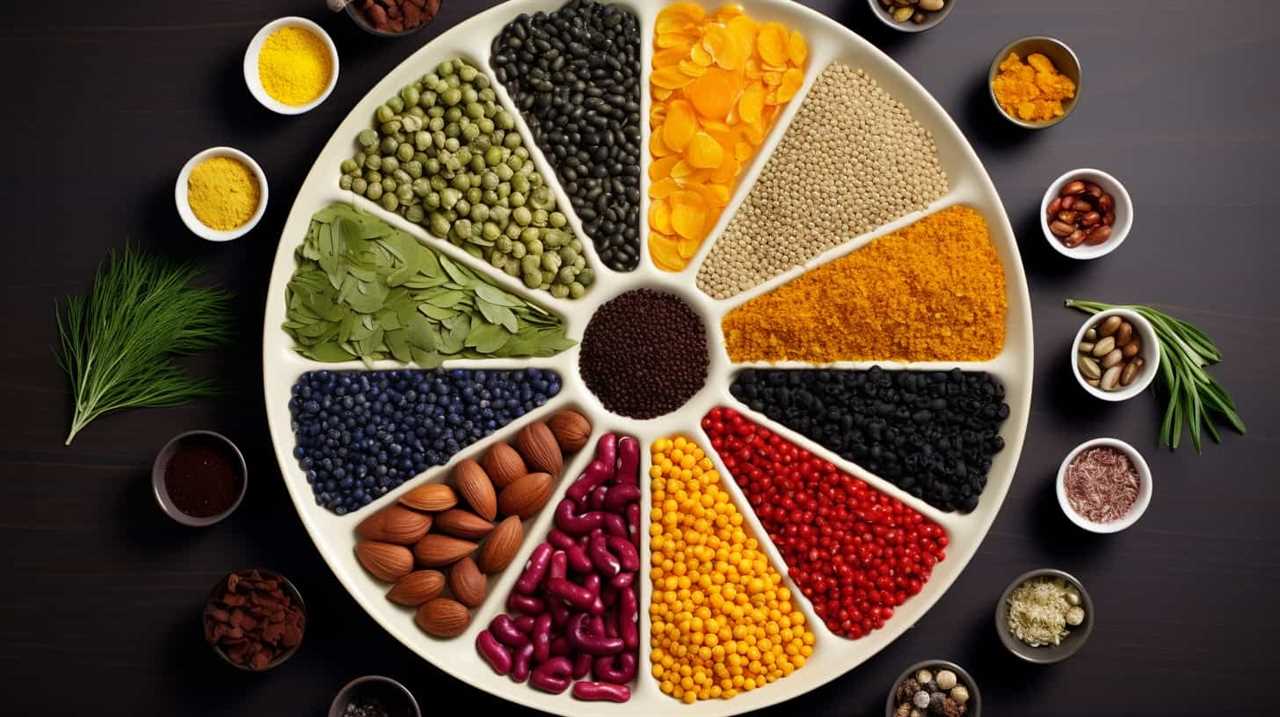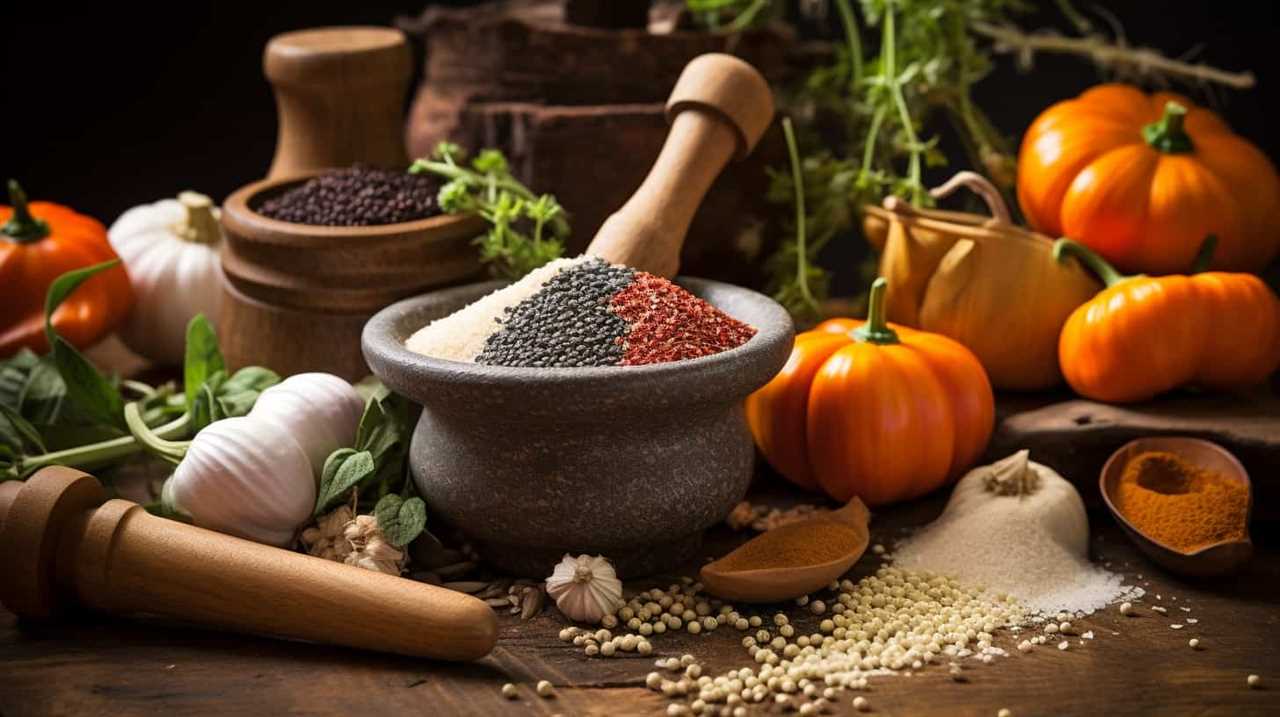Did you know that chia seeds have been around for thousands of years? They were a staple in the diets of ancient civilizations like the Aztecs and Mayans.
Today, chia seeds are gaining popularity for their numerous health benefits. In this article, we’ll take you on a hilarious journey through the history of chia, exploring its ancient origins and its role in modern times.
So sit back, relax, and prepare to be amazed by the seed of time!
Key Takeaways
- Chia seeds have been a staple food for thousands of years and were used by ancient civilizations like the Aztecs and Mayans.
- Chia seeds are packed with fiber, protein, omega-3 fatty acids, and various vitamins and minerals, making them highly nutritious.
- Chia played a significant role in the economy and trade networks of pre-Columbian civilizations, and advanced agricultural methods were used to cultivate it.
- Chia seeds continue to be popular today and are used in various dishes and recipes for their nutritional benefits and versatility.
Ancient Origins of Chia Seeds
The ancient origins of chia seeds can be traced back to indigenous cultures in Mesoamerica. These little seeds were a staple in the diets of the Aztecs and Mayans, who recognized their incredible nutritional value. Chia seeds are a true nutritional powerhouse, packed with fiber, protein, omega-3 fatty acids, and various vitamins and minerals. They were highly valued for their ability to provide sustained energy and promote overall health and well-being.

Not only were chia seeds prized for their nutritional benefits, but they also had a wide range of culinary uses. The Aztecs and Mayans used chia seeds as a key ingredient in beverages, porridges, and breads. They were also used as a thickening agent in sauces and as a substitute for eggs in baking.
Today, chia seeds continue to be popular in various dishes, from smoothies and puddings to salads and baked goods. Their versatility and health benefits make them a must-have ingredient in any kitchen.
Chia in Pre-Columbian Civilizations
After exploring the ancient origins of chia seeds in Mesoamerica, we now delve into the role of chia in the civilizations that thrived before the arrival of Columbus.
Chia wasn’t only a valuable food source, but it also played a significant role in the economy and trade networks of these pre-Columbian civilizations. Chia farming techniques were highly developed, with the Aztecs and Mayans cultivating the crop using advanced agricultural methods. They understood the importance of chia as a nutritious and versatile food, but they also recognized its value as a trade commodity.

Trade routes were established, connecting different regions and allowing for the exchange of chia seeds along with other goods. These trade networks helped spread the knowledge and benefits of chia throughout Mesoamerica.
Transitioning into the subsequent section about chia as a staple food in Mesoamerica, we’ll explore how chia became an essential part of the diet in these ancient civilizations.
Chia as a Staple Food in Mesoamerica
Continuing our exploration of chia in pre-Columbian civilizations, we find that chia became a staple food in Mesoamerica due to its nutritional value and adaptability. Chia seeds are rich in omega-3 fatty acids, fiber, protein, and antioxidants, making them a highly nutritious addition to the diet. They’re also a good source of calcium, phosphorus, and magnesium, essential minerals for maintaining strong bones and overall health.
In contemporary cuisine, chia seeds have gained popularity for their health benefits and versatility. They can be sprinkled on top of salads, added to smoothies, or used as an egg substitute in baking. Chia pudding has become a trendy and delicious breakfast option, providing a filling and nutritious start to the day.

As we delve further into the history of chia, we’ll now explore its role in Aztec and Mayan culture, where it held immense significance and reverence.
Chia’s Role in Aztec and Mayan Culture
Chia played a significant role in the culture of both the Aztecs and Mayans, shaping their diets, religious practices, and daily life.
In Aztec agriculture, chia was one of the main crops cultivated due to its high nutritional value and versatility. The Aztecs used chia seeds as a staple food, consuming them in various forms such as grinding them into flour or mixing them with water to create a refreshing beverage.
In Mayan religious ceremonies, chia seeds held great symbolic significance. They were often used as offerings to the gods and were believed to possess spiritual powers. Additionally, chia seeds were used to create intricate patterns and designs during religious rituals and ceremonies.

Chia Seeds in Modern Times
In our modern times, we see how chia seeds have continued to play a significant role in our diets and health practices. These tiny seeds have become a staple in culinary trends and have gained popularity for their numerous health benefits.
Chia seeds have become a versatile ingredient, used in a variety of recipes such as smoothies, puddings, and baked goods. They add a nutritional boost with their high fiber and omega-3 fatty acid content. Chia seeds are also known for their ability to absorb liquid and create a gel-like consistency, making them a popular choice for vegan egg substitutes and thickening agents.
In terms of health and wellness, chia seeds are praised for their potential to aid in weight loss, regulate blood sugar levels, and improve heart health. They’re also a great source of antioxidants and provide essential nutrients like calcium, magnesium, and phosphorus.
Incorporating chia seeds into our diets can be an easy and beneficial way to support our overall well-being.

Frequently Asked Questions
How Do Chia Seeds Reproduce and Grow?
Chia seeds reproduce and grow through a fascinating life cycle. The germination process involves soaking the seeds in water, allowing them to form a gel-like coating. This gel helps provide the necessary nutrients for the seeds to sprout and develop into healthy chia plants.
What Are the Nutritional Benefits of Chia Seeds?
Chia seeds are a superfood that provide numerous nutritional benefits. They are a vegan source of omega-3 fatty acids, which are important for heart health. Incorporating chia seeds into our diet can support overall well-being.
Can Chia Seeds Help With Weight Loss?
Chia seeds can be a helpful addition to weight loss efforts. They are packed with fiber and protein, which can help you feel full and curb cravings. Try adding them to smoothies or sprinkling them on yogurt for a nutritious boost!
Are There Any Potential Side Effects or Risks Associated With Consuming Chia Seeds?
Potential allergic reactions and choking hazards are associated with consuming chia seeds. It’s important to be aware of these risks and take necessary precautions. However, when enjoyed in moderation, chia seeds can be a nutritious addition to a balanced diet.

How Can Chia Seeds Be Incorporated Into Everyday Meals and Recipes?
Chia seeds can be easily incorporated into everyday meals and recipes. They can be sprinkled on top of desserts for added texture and nutrition, or blended into smoothies for a nutrient-packed boost.
Conclusion
And so, as we bid adieu to the wondrous journey through the history of chia seeds, we can’t help but marvel at their humble beginnings and their rise to prominence in Mesoamerican culture.
From being a staple food for civilizations long gone, to now gracing the shelves of health food stores and trendy smoothie bowls, chia seeds have truly stood the test of time.
So next time you sprinkle these little wonders on your yogurt, remember the ancient civilizations that paved the way for this superfood sensation.

Long live the chia!
















